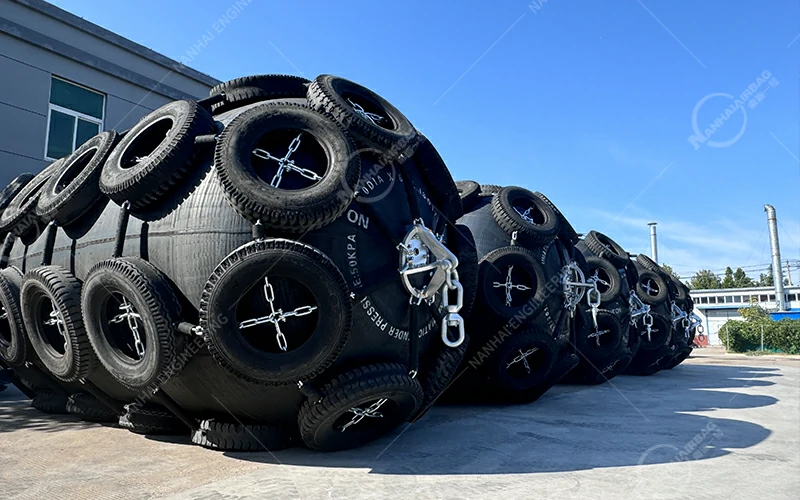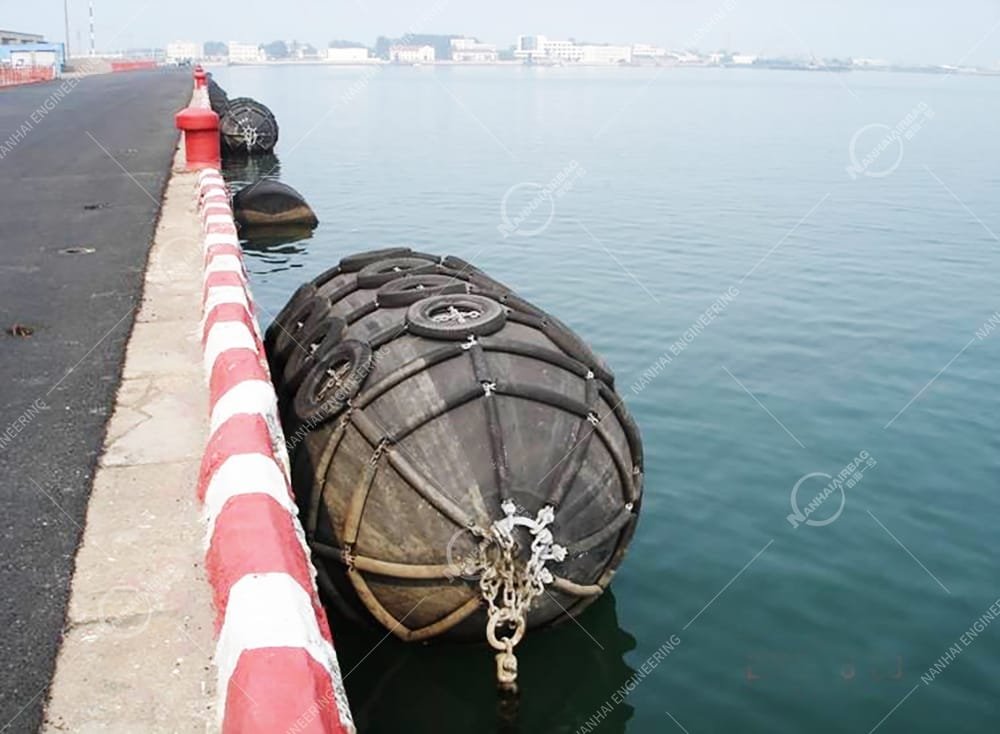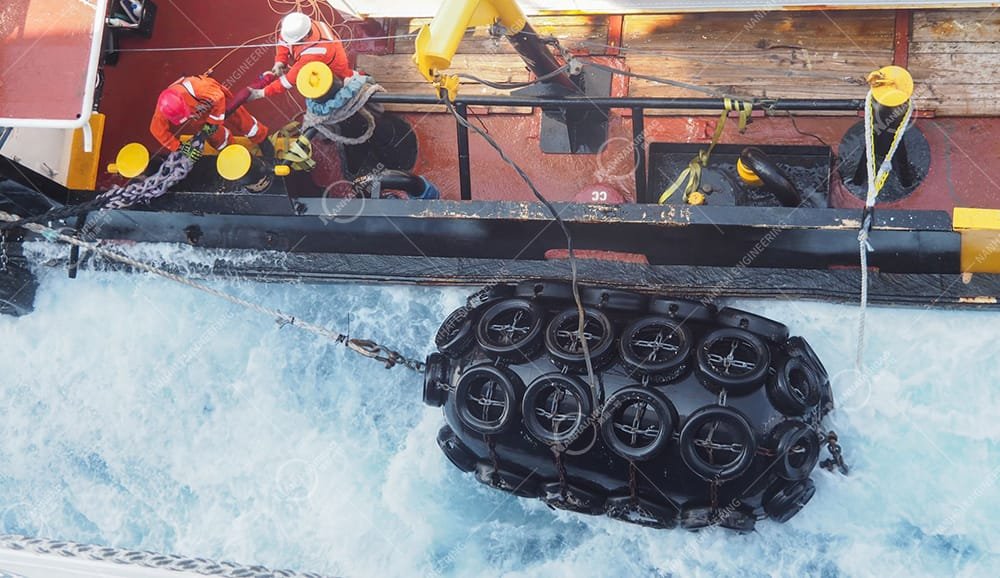Best Ship Launching Method for Small Shipyards 2025
09/08/2025Foam Filled Marine Fenders: Reliable Protection for Vessels and Docks
09/10/2025High-Quality Pneumatic Rubber Fenders
When vessels berth at ports, offshore platforms, or during ship-to-ship operations, safety and reliability are critical. High-quality pneumatic rubber fenders play a key role in protecting ships and infrastructure by absorbing energy and reducing reaction forces during impacts. Choosing the right fender and understanding its performance characteristics can significantly reduce maintenance costs, downtime, and safety risks.
In this guide, we will explore what makes a pneumatic fender “high quality,” how manufacturing affects performance, and what you need to consider when selecting the right fender for your project.
1. Why High-Quality Pneumatic Rubber Fenders Matter
In marine environments, vessels frequently face unpredictable weather, strong currents, and challenging docking conditions. Poor-quality fenders can lead to structural damage, increased repair costs, and even operational delays. High-quality pneumatic fenders provide:
- Superior energy absorption – Protects both vessels and quay walls.
- Low reaction forces – Minimizes stress on hulls and structures.
- Durability – Resistant to wear, punctures, and harsh environmental conditions.
- Versatility – Suitable for ports, offshore platforms, shipyards, and ship-to-ship transfers.
These advantages make high-quality pneumatic rubber fenders a cost-effective and safe solution for modern marine operations.

2. Key Performance Indicators (KPIs) for High-Quality Fenders
When evaluating fenders, engineers focus on several technical parameters that determine safety and efficiency. Below are the most important performance indicators:
2.1 Energy Absorption
The primary role of a pneumatic fender is to absorb kinetic energy during berthing. A high-quality fender delivers high energy absorption without requiring excessive size or weight, which makes it suitable for tight docking spaces.
2.2 Reaction Force
Reaction force is the amount of force transferred back to the vessel or structure during compression. Lower reaction forces reduce the risk of hull deformation and minimize structural damage to berthing facilities.
2.3 Deformation and Restorability
A good fender can deform significantly under pressure and quickly recover its original shape without permanent damage. Look for specifications that indicate consistent compression performance over repeated cycles.
2.4 Puncture and Abrasion Resistance
Marine environments often involve sharp edges, rough weather, and abrasive surfaces. High-quality pneumatic fenders use specially formulated rubber compounds and reinforced outer layers to resist cuts, tears, and punctures.
2.5 Air Retention and Pressure Stability
Reliable fenders maintain internal air pressure over long periods, even in extreme conditions. High-end models feature precision-engineered valves and airtight layers that minimize leakage and reduce maintenance requirements.
2.6 Weather and UV Resistance
Exposure to sun, ozone, saltwater, and temperature fluctuations can cause premature aging. Premium pneumatic fenders use rubber compounds designed to resist cracking, hardening, and UV degradation, ensuring a longer lifespan.

3. Materials and Structural Design
The durability and performance of pneumatic fenders are closely linked to their materials and construction quality.
3.1 Rubber Compounds
High-quality fenders use advanced blends of natural and synthetic rubber. These compounds are engineered for optimal elasticity, tensile strength, and resistance to weathering and abrasion.
3.2 Reinforcement Layers
Inside every fender are multiple layers of high-tensile synthetic cord fabrics arranged at calculated angles. These layers give the fender structural strength and ensure uniform pressure distribution under heavy loads.
3.3 Valve and End Fittings
Reliable valves ensure airtight performance, while strong end fittings and flanges provide secure anchoring points for chains or ropes. Poor-quality components often fail under stress, leading to dangerous operational risks.
3.4 Protective Features
In demanding environments, fenders may include chain-and-tire nets or composite sleeves. These additional protections safeguard the fender body from accidental cuts and enhance operational safety.

4. Manufacturing and Quality Control
The production process plays a decisive role in fender performance. High-quality pneumatic fenders come from manufacturers with strict quality control procedures.
4.1 Precision Manufacturing
- Rubber mixing and compounding – Ensures uniform material properties.
- Layered construction – Reinforcement cords are applied with precision to maximize structural integrity.
- Vulcanization – Heat and pressure treatment guarantee consistent elasticity and durability.
4.2 Rigorous Quality Testing
Before leaving the factory, each fender undergoes comprehensive testing:
- Dimensional checks – Ensures accurate diameter, length, and wall thickness.
- Air pressure and leakage tests – Verifies long-term pressure stability.
- Compression performance tests – Confirms energy absorption and reaction force ratings.
- Aging and UV resistance tests – Simulates long-term exposure to harsh environments.
4.3 Certification and Standards
Leading manufacturers comply with ISO 17357-1:2014 for pneumatic fenders, ensuring safety, consistency, and interchangeability worldwide. Buyers should always request test reports and certification documents before purchasing.
5. Fender Selection Guide
Choosing the right pneumatic fender involves balancing performance, cost, and operational requirements. Here’s a step-by-step approach:
5.1 Define Your Requirements
- Vessel size, type, and displacement
- Berthing energy and operational frequency
- Environmental conditions: tides, waves, currents
- Type of operation: port berthing, offshore platform, or ship-to-ship transfer
5.2 Analyze Key Specifications
Check the manufacturer’s technical data sheet for:
- Diameter × length (affects energy absorption)
- Operating pressure (low vs. standard)
- Energy absorption and reaction force curves
- Reinforcement structure and material grade
- Surface protection options (e.g., chain-and-tire nets)
5.3 Avoid Common Selection Mistakes
- Choosing undersized fenders → insufficient energy absorption
- Ignoring environmental factors → premature wear and failure
- Overlooking certifications → potential safety hazards
- Failing to match fenders with mooring infrastructure → inefficient performance
By following these steps, operators can ensure safer berthing operations and reduce long-term maintenance costs.
6. Case for Quality: Long-Term Cost Savings
While low-cost alternatives may seem appealing, high-quality pneumatic fenders deliver better lifecycle value. Their superior durability, lower maintenance needs, and longer lifespan often offset initial investments. Over time, operators benefit from fewer replacements, reduced downtime, and minimized repair costs.
7. FAQ
Q1: How long do high-quality pneumatic fenders last?
Typically 8–12 years with proper maintenance, depending on environmental conditions.
Q2: How often should fender pressure be checked?
Once every 3–6 months under normal conditions, more frequently in extreme environments.
Q3: Are chain-and-tire nets always necessary?
Not always. They are recommended for high-impact or abrasive environments.
Q4: Can damaged fenders be repaired?
Small punctures can be patched, but severe damage usually requires replacement.
Q5: Do high-quality fenders require special storage?
Store them in a cool, shaded area away from direct sunlight and sharp objects to prevent aging.
